Synthesis of Tetraaza Derivatives of Benzoxazinophenothiazine
Benjamin E. Ezema*1, Chidimma G. Ezema2, Jude I. Ayogu1, David I. Ugwu1, Efeturi A. Onoabedje1
1Department of Pure and Industrial Chemistry, Faculty of Physical Sciences,University of Nigeria, Nsukka
2National Centre for Energy Research and Development, University of Nigeria, Nsukka.
DOI : http://dx.doi.org/10.13005/ojc/310114
Article Received on :
Article Accepted on :
Article Published : 09 Feb 2015
Tetraaza benzoxazinophenothiazine heterocyclic rings were synthesized and characterized. The key intermediate, 11-amino-6-chlorobenzo[a]-8,10-diazaphenoxazin-5-one was prepared by reaction of 4,5-diamino-6-hydroxypyimidine with 2,3-dichloro-1,4-naphthoquinone in anhydrous sodium carbonate. Whereas the parent tetraaza derivatives: 15-amino-8-bromo-6,9,12,14-tetraazabenzo[a][1,4]benzoxazino[3,2-c] phenothiazine, 9,15-diamino-6,8,12,14-tetraazabenzo[a][1,4]benzoxazino[3,2-c]pheno- thiazine and 15-amino-6,8,12,14-tetraazabenzo[a][1,4]benzoxazino[3,2-c]phenothiazine were synthesized by base catalyzed condensation reactions of 11-amino-6-chlorobenzo[a]-8,10-diazaphenoxazin-5-one with 2-amino-5-bromopyrazin-3-thiol, 4,6-diaminopyrimidine-5-thiol and 4-diaminopyrimidine-5-thiol respectively. The compounds are intensely coloured and are readily reduced with sodium dithionite to their leuco bases which can make them applicable as vat dyes. Their wash fastness, sublimation fastness and staining undyed fabric were evaluated.
KEYWORDS:2-Amino-5-bromopyrazin-3-thiol; 4;5-diamino-6-hydroxypyimidine; 4;6-diaminopyrimidine-5-thiol; 2;3-dichloro-1;4-naphthoquinone; Leuco Base; Vat dye; alkaline hydrolysis; condensation reaction
Download this article as:| Copy the following to cite this article: Ezema B. E, Ezema C. G, Ayogu J. I, Ugwu D. I, Onoabedje E. A. Synthesis of Tetraaza Derivatives of Benzoxazinophenothiazine. Orient J Chem 2015;31(1). |
| Copy the following to cite this URL: Ezema B. E, Ezema C. G, Ayogu J. I, Ugwu D. I, Onoabedje E. A. Synthesis of Tetraaza Derivatives of Benzoxazinophenothiazine. Orient J Chem 2015;31(1). Available from: http://www.orientjchem.org/?p=7068 |
Introduction
The application of phenoxazine and phenothiazine compounds and their derivatives in drug, textile, agriculture and other related industries has long been recognized. Phenoxazine and its derivatives were found to show tremendous pharmacological activities as antiepileptic, sedatives, CNS depressants, tranquilizing agents, antitumor,1 antibacterial, anthelminthic, spasmolytic, anticancer 2 and parasticidal agents.3 Other applications include their use as antioxidants and biological stains, 4 laser dyes, 5 acid-base indicators, bromometric and stannometric indicators 6 and especially as chromophoric compound 7 in host guest artificial protonic antenna system.
However, phenothiazines and their derivatives are useful in medicine as antitussive and antitumor agents, anticonvulsants, tranquilizers, antipsychotics, antimalarial agents 8and in the treatment of prion diseases 9, to mention but a few. In textile, paint and plastic industries, they are used as vat dyes and pigments 10; and in agricultural industries, as insecticides and nematodicides. 11 In petroleum industries, they have been found useful as antioxidants in lubricants and fuels. 12
The three-branched fused phenothiazine ring of the type 1 13 has been known for more than a century. The monoaza-, diaza- and triaza-analogues of benzoxazinophenothiazine rings of the types 2, 3, 4 14 have been known. The authors wish to report here the successful synthesis of tetraaza-analogue.
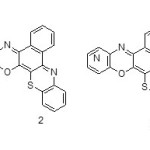 |
Scheme Click here to View Scheme |
Experimental
The solvents were of analytical grade from Sigma-Aldrich. 2-aminopyrazine, 4,6-diaminopyrimidine, 4,5-Diamino-6-hydroxypyrimidine and 2,3-dichloro-1,4-naphthoquinone were also products of Aldrich chemicals. Melting points were determined using electrothermal melting point apparatus in open capillaries and were uncorrected. The reactions were monitored with TLC and also the purity was ascertained with TLC. Infrared spectra were recorded on FT-IR 8400S spectrophotometer using KBr discs. Nuclear magnetic resonance spectra (1H-NMR and 13C-NMR) were determined using Brucker 300 MHz instrument; chemical shifts were reported on (ppm) scale.
Elemental analysis was obtained on Heraous rapid analyzer.
2-Amino-5-bromopyrazin-3-thiol (8)
Procedure as reported in literature. 15
A mixture of 2-amino-3,5-dibromopyrazine 6 (10 g, 42 mmole) and sodium hydrosulphide (4.86 g, 84 mmole) was poured in a 250 mL reaction flask attached to reflux condenser. Methanol (100 mL) was added and the mixture was refluxed for 13 h in water bath. A little amount of activated carbon was added and the mixture boiled for additional 15 min. It was then filtered and the filtrate was allowed to cool. It was neutralized with dilute hydrochloric acid to give dirty brown precipitates which was filtered and dried in a desiccator. Pure sample for analysis were further recrystallized from aqueous DMF. M.p. > 300 oC; FT-IR (KBr): ν max 3488, 3420 (NH2), 1589 (C=C, C=N), 770 and 728 cm-1.
4,6-Diamino-5-thiocyanatopyrimidine (10)
4,6-Diaminopyrimidine 9 (15.00 g, 14 mmol) was poured into a litre of three-necked flask equipped with a reflux condenser, mechanical glass stirrer and dropping funnel. Glacial acetic acid cooled to 18 oC was added and the mixture was further cooled in an ice-salt bath. Sodium thiocyanate (22.00 g) was added with stirring while maintaining the temperature at -5 oC and 0 oC. Bromine (8.00 mL) was added in droplets from the dropping funnel to the ice cooled mixture for over 1 h and stirring was continued for a period of 5 h while maintaining the temperature near 0 oC. The slurry was left overnight, water was added and mixture warmed to 80 oC and filtered hot. The filtrate was preserved and the orange residue extracted with acetic acid. The acetic acid extract was combined with the preserved filtrate and neutralized with concentrated ammonia while cooling and maintaining the temperature below 30 oC. It was then filtered and the residue recrystallized from methanol to give 4,6-diamino-5-thiocyanatopyrimidine as bright yellow solid, m.p.181-182 oC (lit. 183-184 oC) [15]; FT-IR (KBr): ν max 3475, 3415 (NH2), 1579 (C=C, C=N), 1160, 790 and 730 cm-1.
4, 6-Diaminopyrimidine-5-thiol (11)
4,6-Diamino-5-thiocyanatopyrimidine 10 (12.00 g, 72 mmol) was added into a reaction flask containing potassium hydroxide (40 g) water (100 mL). The mixture was refluxed in sand bath for 13 h until ammonia gas ceased to evolve. Activated carbon was added to the mixture and it was refluxed for further 20 min, it was filtered hot and the filtrate allowed cooling. It was neutralized with glacial acetic acid in ice-salt bath while maintaining the temperature below 10 oC. It was filtered and the residue recrystallized from methanol to give 4,6-Diaminopyrimidine-5-thiol (11) as yellow crystals.
FT-IR (KBr): ν max 3480, 3413 (NH2), 1590 (C=C, C=N), 1140, 1080 780 and 735 cm-1.
11-Amino-6-chlorobenzo[a]-8,10-diazaphenoxazin-5-one (14)
4,5-Diamino-6-hydroxypyrimidine 12 (2.0 g, 15 mmol) and anhydrous sodium carbonate (2.5 g, 23 mmol) were poured in a three-necked reaction flask (250 mL). A solution of benzene (120 mL) and DMF (15 mL) was added and the mixture was boiled for 45 min until complete dissolution. 2,3-Dichloro-1,4-naphthoquinone 13 (3.60 g, 15 mmol) was later added and the mixture refluxed for 5 h in water bath at 75-80 oC. At the end of the reflux period, benzene was distilled off and the slurry poured into water (100 mL) and stirred to dissolve the inorganic material. It was cooled overnight, filtered and the residue was recrystallized from acetone after treatment with activated carbon to give 11-amino-6-chlorobenzo[a]-8,10-diazaphenoxazin-5-one 14 as deep orange powder; m.p. 290-291 oC. FT-IR (KBr): νmax 3470, 3339 cm-1, (NH2), 1655 (C=O), 1589, 1540 (C=C, C=N). 1H-NMR (DMSO) ppm: 7.80-7.70 (5H, m, Ar-H), 6.90 (s, NH2). 13C-NMR (CDCl3) ppm: 191.3 (C=O), 168.7, 165.8, 161.3, 150.3, 148.3, 137.5, 134.1, 133.0, 131.2, 129.9, 137.8, 126.9, 116.5 .
Analysis: Calculated for C14H7N4ClO2: (%): C, 56.30; H, 2.36; N, 18.76; Cl, 11.87.
Found: C, 56.32; H, 2.36; N, 18.74; Cl, 11.89.
General Procedure for the Preparations of the Complex Compounds
2-Amino-5-bromopyrazin-3-thiol 8 (2.0 g, 97 mmol) and anhydrous sodium carbonate (1.0 g, 97 mmol) were poured in 3-necked reaction flask (250 mL) containing a solution of benzene (100 mL) and DMF (20 mL). The mixture was warmed in a water bath for 45 min until complete dissolution. 11-Amino-6-chlorobenzo[a]-8,10-diazaphenoxazin-5-one 14 (2.89 g, 97 mmol) was later added and the entire mixture was refluxed in a water bath with continuous stirring for 11 h. Benzene was distilled off and the slurry was poured into water (600 mL) and warmed to dissolve the inorganic material. It was filtered, washed with water, recrystallized from aqueous acetone and later treated with activated charcoal to yield 18 as intense red powder. M. p. > 320 o (dec.); IR (KBr): νmax cm-1 3466, 3396 (NH2), 1598, 1472 (C=N, C=C). 1H-NMR (DMSO) ppm: 9.10 (H-7, s), 7.85-7.70 (m, H1, H2, H3, H4), 6.90 (br, NH2); 13C-NMR (CDCl3) ppm: 157.7, 153.0, 151.5, 148.1, 147.1, 145.8, 139.2, 137.6, 136.0, 134.4, 132.2, 130.6, 130.0, 119.5.
Analysis: Calculated for C18H8N7OS Br: (%): C, 48.01, H, 1.79, N, 21.77, S, 7.12, Br, 17.75. Found: C, 48.05, H, 1.77, N, 21.77, S, 7.12, Br, 17.76.
9, 15-Diamino-6,8,12,14-tetraazabenzo[a][1,4]benzoxazino[3,2-c]phenothiazine (22)
4,6-Diaminopyrimidine-5-thiol 11 (2.0 g, 14 mmol) was condensed with 11-Amino-6-chlorobenzo[a]-8,10-diazaphenoxazin-5-one 14 (4.20 g, 15 mmol) in presence of anhydrous sodium carbonate (1.67 g, 15 mmol) to give 9,15-diamino-6,8,12,14-tetraazabenzo[a][1,4]benzoxazino[3,2-c]phenothiazine as reddish brown powder. mp > 300o (dec.); FT-IR (KBr): νmax cm-1 3450, 3376 (2NH2), 1590, 1482 (C=N, C=C); 1H-NMR (DMSO) ppm: 8.35 (1H, s, H-7), 7.90-7.75 (m, H1, H2, H3, H4) and 6.91 (2NH2, s), 13C-NMR (CDCl3) ppm: 159.7, 157.0, 155.5, 152.1, 147.1, 138.8, 135.2, 126.6, 123.0, 121.4, 120.2, 119.6, 119.0, 118.7 .
Analysis: Calculated for C18H10N8OS: (%): C, 55.95, H, 2.61, N, 29.00, S, 8.30,
Found: C, 55.97, H, 2.59, N, 29.03, S, 8.29.
15-Amino-6,8,12,14-tetraazabenzo[a][1,4]benzoxazino[3,2-c]phenothiazine (22)
4-Aminopyrimidine-5-thiol 11 (2.0 g, 15 mmol) condensed with 11-Amino-6-chlorobenzo[a]-8,10-diazaphenoxazin-5-one 14 (4.69 g, 15 mmol) in the presence of anhydrous sodium carbonate (1.67 g, 15 mmol) to give 15-amino-6,8,12,14-tetraazabenzo[a][1,4]benzoxazino[3,2-c]phenothiazine as dark purple brown powder mp > 320o (dec.). FT-IR (KBr): νmax cm-1 3450, 3376 (NH2), 1598, 1472 (C=N, C=C).
1H-NMR (DMSO) ppm: 8.70 (s, H-7), 8.55 (s, H-9), 7.8-7.75 (m, H1, H2, H3, H4) and 6.50 (NH2, s), 13C-NMR (CDCl3) ppm: 159.7, 157.0, 155.5, 152.1, 147.1, 145.8, 143.2, 136.6, 133.0, 131.4, 130.2, 129.6, 129.0, 119.7
Analysis: Calculated for C18H10N8OS: (%): C, 58.22, H, 2.44, N, 26.40, S, 8.63,
Found: C, 58.27, H, 2.44, N, 26.38, S, 8.67.
General Method of Dyeing with the Compounds 14, 18 and 22
The dye compounds (0.20 g) each were weighed into separate reaction flasks attached to reflux condensers and thermometers. Acetone (60 mL) was added to the separate reaction mixtures each and warmed in water bath to achieve dissolution. Little volume of DMF (5.0 mL) was also added to aid complete dissolution. Sodium dithionite (5.0 g) was later added and the mixtures refluxed for 2 h and allowed to cool to 40 oC. Pieces of rayon fabrics were inserted into the separate solutions followed by addition of glacial acetic (5.0 mL). The mixtures were refluxed with gradual increase in temperature and occasional agitation for further 1 h. They were quickly cooled to room temperature and the fabrics were removed and air-dried. Their wash fastness, stain on undyed fabric and sublimation fastness based on the international geometric gray standard (1 for poor and 5 for excellent respectively) were ascertained.
Results and discussion
2-Aminopyrazine 5 was converted to 3,5-dibromo-2-aminopyrazine 6 by treating with bromine in acetic acid and sodium acetate. Refluxing 6 in methanol and sodium hydrosulphide for 13 h gave the sodium salt 7 which was then neutralized with glacial acetic acid to give 2-amino-5-bromopyrazin-3-thiol 8 as brownish ash powder. On the other hand, 4,6-diaminopyrimidine 9 was thiocyanated with sodium thiocyanate dihydrate in glacial acetic and bromine at -5 oC to give 4,6-diamino-5-thiocyanatopyrimidine 10. Alkaline hydrolysis of 10 in 40 % KOH followed by neutralization with acetic acid gave 4,6-diaminopyrimidine-5-thiol 11 (scheme 1).
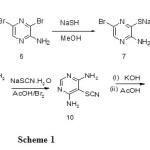 |
Scheme 1 Click here to View scheme |
When 4,5-diamino-6-hydroxypyimidine 12 was treated with 2,3-dichloro-1,4-naphthoquinone 13 in anhydrous sodium carbonate and benzene/DMF, the concomitant product 11-amino-6-chlorobenzo[a]-8,10-diazaphenoxazin-5-one 14 was obtained as a deep orange solid. Elemental analysis agrees with the molecular formular C14H7N4O2Cl. FT-Infrared spectrum gave bands at 3441, 3344cm-1for (N-H) and at 1675 cm-1 for (C=O). 1H and 13C-NMR provided further support for the assigned structure. The 1H-NMR could not resolve the individual protons but gave multiplet at ppm 7.80-7.70 due to aromatic protons while the singlet at 6.90 ppm was assigned to NH2. 13C-NMR gave prominent chemical shift at ppm 191.3 for C=O (scheme 2).
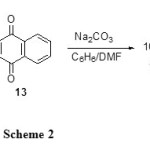 |
Scheme 2 Click here to View scheme |
Formation of compound 14 is proposed as follows (Scheme 3).
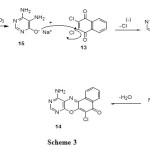 |
Scheme 3 Click here to View scheme |
The presence of reactive halogen and carbonyl groups in compound 14 led to the consideration of further extension of the conjugated ring system. This was achieved by refluxing 11-amino-6-chlorobenzo[a]-8,10-diazaphenoxazin-5-one 14 with 2-amino-5-bromopyrimidine-3-thiol 8 in a basic medium of anhydrous sodium carbonate for 11 h to furnish one of the tetraaza heterocycles 15-amino-8-bromo-6,9,12,14-tetraazabenzo[a] [1,4]benzoxazino[3,2-c]phenothiazine 18 as an intense red powder mp > 300 oC.
Structure 18 was assigned based on the spectra and elemental analysis. The elemental analysis was in agreement with the molecular formula C18H8N7OSBr. The FT-infrared spectrum gave bands at 3401, 3346 cm-1 (NH), 1598 and 1472 cm-1 (aromatic C=C, C=N). The chemical shifts in the 1H-NMR at ppm 9.10 (H-7, s), 7.85-7.70 (m, H-1, H-2, H-3, H-4), 6.90 (br, NH2) were in support of structure 18. 13C-NMR gave further evidence of the assigned structure. (Scheme 4)
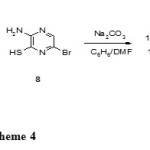 |
Scheme 4 Click here to View scheme |
Product 18 was likely formed by the proposed mechanism (Scheme 5).
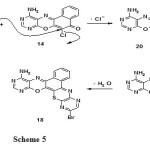 |
Scheme 5 Click here to View scheme |
When 11-amino-6-chlorobenzo[a]-8,10-diazaphenoxazin-5-one 14 was also treated with 4,6-diaminopyrimidine-5-thiol 11 in anhydrous sodium carbonate, another tetraaza heterocycle 9,15-diamino-6,8,12,14-tetraazabenzo[a][1,4]benzoxazino[3,2-c]pheno- thiazine 22 (R = NH2) was obtained as reddish brown powder. The elemental analysis of 22 agreed with the molecular formular C18H10N8OS. 1H and 13C NMR gave further support for the assigned structure. Compound 22 exhibited proton chemical shifts signals in ppm as follows: 8.35 (s, H-7), 7.90-7.75 (m, H-1, H-2, H-3, H-4) and 6.79 (2NH2, br).
Again, treatment of 14 with 4-aminopyrimidin-5-thiol gave 15-amino-6,8,12,14-tetraazabenzo[a][1,4]benzoxazino[3,2-c]phenothiazine 22 (R = H) as dark purple brown powder: The elemental analysis of 22 (R = H) agreed with the molecular formular C18H9N7OS. 1H and 13C NMR gave further support for the assigned structure. The compound 22 exhibited the following protons chemical shifts signals in ppm: 8.70 (s, H-7), 8.55 (s, H-9), 7.8-7.75 (m, H-1, H-2, H-3, H-4) and 6.50 (NH2, s) (scheme 6).
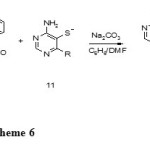 |
Scheme 6 Click here to View scheme |
Formation of 22 follows the proposed mechanism as in scheme 7 below:
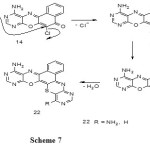 |
Scheme 7 Click here to View scheme |
Dyeing of nylon fabric with synthesized dyes
The new compounds are vat dyes and they are applied in their reduced state. Dyeing was carried out in the presence of sodium dithionite and in aqueous solution of acetone/DMF/ acetic acid. They exhibited good to excellent shades on the rayon fabric and showed excellent wash fastness and good sublimation fastness based on the international geometric gray standard (1 for poor and 5 for excellent respectively) as presented in the table.
Table1: fastness properties of synthesized heterocyclic dyes
| Dye no |
Wash fastness (1-5) |
Stain on undyed fabric after washing (1-5) Rayon cotton |
Sublimation fastness (1-5) |
Stain on undyed fabric after sublimation (1-5) rayon cotton |
|
14 |
3 |
3 3-4 |
3 |
3 4 |
|
18 |
4 |
4 4-5 |
4 |
4 4-5 |
|
22 (R=NH2) |
4-5 |
4 4-5 |
4 |
4 4-5 |
|
22 (R=H) |
4 |
4 5 |
4 |
4 4-5 |
Conclusion
Tetraaza heterocyclic compounds were synthesized and characterized by spectral and elemental analysis. Their ease of reduction with sodium hydrosulphide (sodium dithionite) makes them applicable as vat dyes. Their wash fastness, sublimation fastness and staining undyed fabric were evaluated.
References
- Shimamoto, T.; Tomoda, A.; Ishida, R.; Ohyashiki, K. Clin Cancer Res. 2001,7(3),704-708.
- Horton, J. K.; Thimmaiah, K. N.; Harwood, F. C.; Kuttesch, J. F.; Houghton, P. J. Mol. Pharmacol. 1993, 44, 552-559.
- Molnár, J; Mándi, Y; Király, J. Acta Microbio.l Acad. Sci. Hung. 1976, 23(1), 45-54.
- Eregowda, G. B.; Kalpana, H. N.; Hegbe, R.; Thimmiah, K. N. Indian J. Chem. B, 2000, 39(4), 243-259.
- Maas, H.; Khatyr, A.; Calzaferri, G. Microporus and mesoporus material, 2003, 65, 233-242.
- Musha, S; Kitagawa, T; Nippo, K. Z. Chem. Abstract. 1957, 76.
- Jenk, W.S. Advances in photochemistry. John Wiley & Sons, Inc. Hokoken, 2002, 27, 1-50.
- Kalkanidis, M.; Klonis, N.; Tilley, L.; Deady, L. W. Biochem Pharmacol, 2002, 63(5), 833
- Korth, L. H. National Academy of Science, 2001, 17, 9836-9841.
- Okafor, C. O.; Okerelu, I. O.; Okeke, S. I. Dyes and Pigments, 1987, 8, 11-24
- Mitchell, S. C. Drug Metabolism. Rev., 1982, 13, 319-343.
- Murphy, C. M.; Rarner, H.; Smith. N. L. Ind. Eng. Chem. 1950, 42, 2479
- Agarwal, N. L.; Mital. R. L. Indian J. Chem.1976, 14, 381
- Okafor, C. O. Tetrahedron, 1988, 44, 1187-1194.
- Okafor, C. O. Journal of Heterocyclic Chemistry, 1980, 17, 1587-1592.

This work is licensed under a Creative Commons Attribution 4.0 International License.









